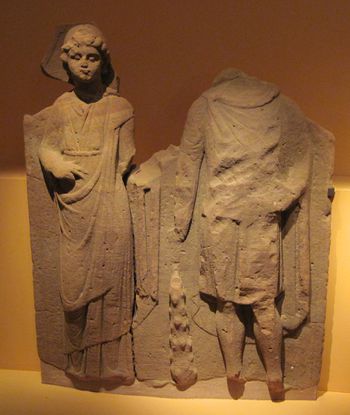「アンカンマ」の版間の差分
| 1行目: | 1行目: | ||
[[File:Ancamna MarsSmertrius HistMusPfalz 3477.jpeg|right|thumb|350px|古代ネメテス領のフレッケンフェルトから出土したアンカンマとマールース・スメルトリウスを描いたもの。]] | [[File:Ancamna MarsSmertrius HistMusPfalz 3477.jpeg|right|thumb|350px|古代ネメテス領のフレッケンフェルトから出土したアンカンマとマールース・スメルトリウスを描いたもの。]] | ||
| − | ガロ・ローマ時代の信仰では、'''アンカムナ'''(Ancamna)は特にモーゼル川<ref>モーゼル川(モーゼルがわ、ドイツ語:Mosel、フランス語:Moselle - モゼル)は、ヨーロッパのフランス、ルクセンブルクおよびドイツを流れる全長545キロメートルの国際河川である。</ref>の渓谷で崇拝されていた女神である。トリーアとリプスドルフではレヌス・マールスの妃として<ref>H. Finke (1927). "Neue Inschriften," ''Bericht der Römisch-Germanischen Kommission'' 17, inscriptions 12 (= AE:1915|00071), 13 (= EDCS-11201739), 20 (= AE:1915|00070), 254 (= CIL:13|07778).</ref>、メーンではマールス・[[スメルトリオス]]の妃として祭られている<ref>CIL:13|04119.</ref><ref name="Jufer">Nicole Jufer & Thierry Luginbühl. 2001. ''Les dieux gaulois : répertoire des noms de divinités celtiques connus par l'épigraphie, les textes antiques et la toponymie.'' Editions Errance, Paris. pp.14, 21.</ref>。トリアーでは、レヌス・マールス、アンカンナ、トレヴェリの様々なパギ族の精霊神を祀る祭壇が設置され、レヌス・マールスとアンカムナが部族の守護神として公式に編成された教団に祭られているような印象を与えた<ref>Wightman, 1970, page214</ref><ref>Two such surviving inscriptions were published in Finke (1927) "Neue Inschriften," ''Bericht der Römisch-Germanischen Kommission'' 17: inscriptions 12 and 13.</ref>。 | + | ガロ・ローマ時代の信仰では、'''アンカムナ'''(Ancamna)は特にモーゼル川<ref>モーゼル川(モーゼルがわ、ドイツ語:Mosel、フランス語:Moselle - モゼル)は、ヨーロッパのフランス、ルクセンブルクおよびドイツを流れる全長545キロメートルの国際河川である。</ref>の渓谷で崇拝されていた女神である。トリーアとリプスドルフではレヌス・マールスの妃として<ref>H. Finke (1927). "Neue Inschriften," ''Bericht der Römisch-Germanischen Kommission'' 17, inscriptions 12 (= AE:1915|00071), 13 (= EDCS-11201739), 20 (= AE:1915|00070), 254 (= CIL:13|07778).</ref>、メーンではマールス・[[スメルトリオス]]の妃として祭られている<ref>CIL:13|04119.</ref><ref name="Jufer">Nicole Jufer & Thierry Luginbühl. 2001. ''Les dieux gaulois : répertoire des noms de divinités celtiques connus par l'épigraphie, les textes antiques et la toponymie.'' Editions Errance, Paris. pp.14, 21.</ref>。トリアーでは、レヌス・マールス、アンカンナ、トレヴェリの様々なパギ族の精霊神を祀る祭壇が設置され、レヌス・マールスとアンカムナが部族の守護神として公式に編成された教団に祭られているような印象を与えた<ref>Wightman, 1970, page214</ref><ref>Two such surviving inscriptions were published in Finke (1927) "Neue Inschriften," ''Bericht der Römisch-Germanischen Kommission'' 17: inscriptions 12 and 13.</ref>。メーンのマールス・[[スメルトリオス]]とアンカンナの聖域に奉納された数少ない像の中に、トリーアのレヌス・マールス神殿群でクルシギエ神(Xulsigiae)に奉納されたものと同じ、天才ククラトゥス(genius cucullatus)の像が残っている<ref>Wightman, 1970, page224</ref>。 |
| + | |||
| − | |||
[[Inciona]] is also apparently invoked along with Lenus Mars [[Veraudunus]] on a bronze ''ex voto'' from Luxembourg;<ref name="MNHA">Musée d'histoire et d'art, Luxembourg. 1974. ''Pierres sculptées et inscriptions de l'époque romaine'', catalogued by Eugénie Wilhelm, p.71. {{in lang|fr}}</ref> it is unclear what connection, if any, exists between Inciona and Ancamna. Jufer and Luginbühl link Ancamna with two other consorts of the Gaulish Mars, [[Litavis]] and [[Nemetona]], noting that none of these appear to be warrior goddesses themselves; instead, they suggest that Ancamna might have been associated with a [[spring (hydrosphere)|spring]].<ref name="Jufer"/> Edith Wightman considers the couple Mars [[Loucetius]] and [[Nemetona]] to be "closely similar to if not identical with, Lenus and Ancamna".{{sfnp|Wightman|1970|page=219}} | [[Inciona]] is also apparently invoked along with Lenus Mars [[Veraudunus]] on a bronze ''ex voto'' from Luxembourg;<ref name="MNHA">Musée d'histoire et d'art, Luxembourg. 1974. ''Pierres sculptées et inscriptions de l'époque romaine'', catalogued by Eugénie Wilhelm, p.71. {{in lang|fr}}</ref> it is unclear what connection, if any, exists between Inciona and Ancamna. Jufer and Luginbühl link Ancamna with two other consorts of the Gaulish Mars, [[Litavis]] and [[Nemetona]], noting that none of these appear to be warrior goddesses themselves; instead, they suggest that Ancamna might have been associated with a [[spring (hydrosphere)|spring]].<ref name="Jufer"/> Edith Wightman considers the couple Mars [[Loucetius]] and [[Nemetona]] to be "closely similar to if not identical with, Lenus and Ancamna".{{sfnp|Wightman|1970|page=219}} | ||
2022年12月9日 (金) 23:06時点における版
ガロ・ローマ時代の信仰では、アンカムナ(Ancamna)は特にモーゼル川[1]の渓谷で崇拝されていた女神である。トリーアとリプスドルフではレヌス・マールスの妃として[2]、メーンではマールス・スメルトリオスの妃として祭られている[3][4]。トリアーでは、レヌス・マールス、アンカンナ、トレヴェリの様々なパギ族の精霊神を祀る祭壇が設置され、レヌス・マールスとアンカムナが部族の守護神として公式に編成された教団に祭られているような印象を与えた[5][6]。メーンのマールス・スメルトリオスとアンカンナの聖域に奉納された数少ない像の中に、トリーアのレヌス・マールス神殿群でクルシギエ神(Xulsigiae)に奉納されたものと同じ、天才ククラトゥス(genius cucullatus)の像が残っている[7]。
Inciona is also apparently invoked along with Lenus Mars Veraudunus on a bronze ex voto from Luxembourg;[8] it is unclear what connection, if any, exists between Inciona and Ancamna. Jufer and Luginbühl link Ancamna with two other consorts of the Gaulish Mars, Litavis and Nemetona, noting that none of these appear to be warrior goddesses themselves; instead, they suggest that Ancamna might have been associated with a spring.[4] Edith Wightman considers the couple Mars Loucetius and Nemetona to be "closely similar to if not identical with, Lenus and Ancamna".テンプレート:Sfnp
私的注釈
アンカンマとは名前の子音構成から、ギリシア神話のアルクメーネーに相当するのではないだろうか。またシュメール神話のイナンナにも相当するように思う。
Further reading
- Ellis, Peter Berresford (1994). Dictionary of Celtic Mythology (Oxford Paperback Reference), Oxford University Press, Oxford. ISBN 0-19-508961-8
- MacKillop, James (1998). Dictionary of Celtic Mythology. Oxford University Press, Oxford. ISBN 0-19-280120-1.
- テンプレート:Cite book
- Wood, Juliette (2002). The Celts: Life, Myth, and Art. Thorsons Publishers. ISBN 0-00-764059-5
参照
- ↑ モーゼル川(モーゼルがわ、ドイツ語:Mosel、フランス語:Moselle - モゼル)は、ヨーロッパのフランス、ルクセンブルクおよびドイツを流れる全長545キロメートルの国際河川である。
- ↑ H. Finke (1927). "Neue Inschriften," Bericht der Römisch-Germanischen Kommission 17, inscriptions 12 (= AE:1915|00071), 13 (= EDCS-11201739), 20 (= AE:1915|00070), 254 (= CIL:13|07778).
- ↑ CIL:13|04119.
- ↑ 4.0 4.1 Nicole Jufer & Thierry Luginbühl. 2001. Les dieux gaulois : répertoire des noms de divinités celtiques connus par l'épigraphie, les textes antiques et la toponymie. Editions Errance, Paris. pp.14, 21.
- ↑ Wightman, 1970, page214
- ↑ Two such surviving inscriptions were published in Finke (1927) "Neue Inschriften," Bericht der Römisch-Germanischen Kommission 17: inscriptions 12 and 13.
- ↑ Wightman, 1970, page224
- ↑ Musée d'histoire et d'art, Luxembourg. 1974. Pierres sculptées et inscriptions de l'époque romaine, catalogued by Eugénie Wilhelm, p.71. テンプレート:In lang
